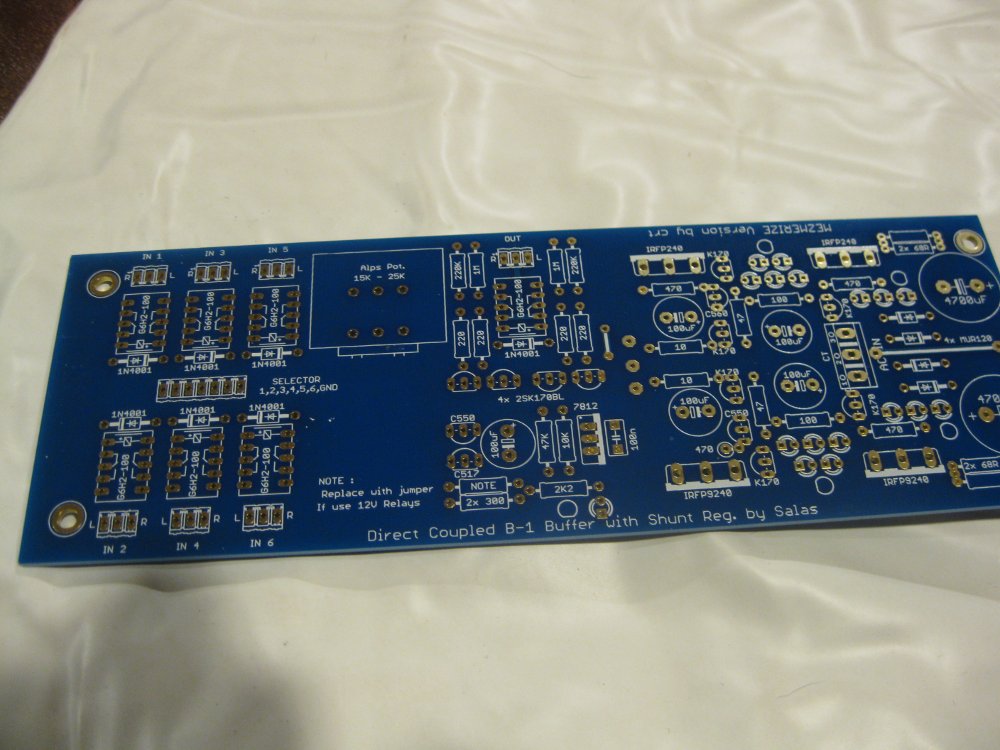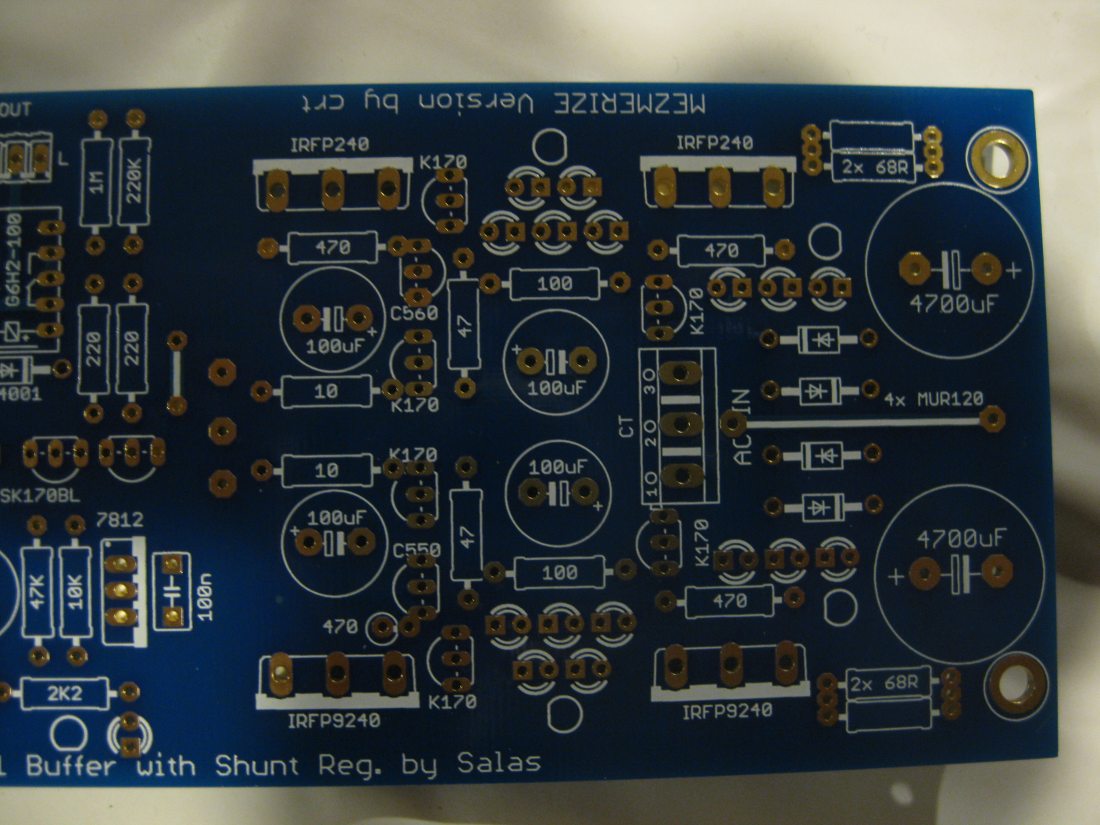I would like to get underway a build thread particularly devoted for Tea-Bags Mesmerize pcb.
There is already a lot of cross referencing material available, from Tea-Bags blog:
http://www.diyaudio.com/forums/blogs/tea-bag/173-old-style-dcb1-information.html
http://www.diyaudio.com/forums/blogs/tea-bag/296-salas-dcb1-blue-edition.html
A build guide can be found here for the Blue Edition v1.0.4 pcb:
DC-Coupled B1 Buffer Build
I know a few members from the Mesmerize GB are building balanced versions including myself, I’m after as much info regarding this option, in particular wiring schemes for inputs, outputs and switching etc.
Those of you with greater knowledge please chip in when possible 😀
I’m looking forward to receiving my boards and getting started. Many thanks to Salas, Tea-Bag and others.
Let’s discuss.
There is already a lot of cross referencing material available, from Tea-Bags blog:
http://www.diyaudio.com/forums/blogs/tea-bag/173-old-style-dcb1-information.html
http://www.diyaudio.com/forums/blogs/tea-bag/296-salas-dcb1-blue-edition.html
A build guide can be found here for the Blue Edition v1.0.4 pcb:
DC-Coupled B1 Buffer Build
I know a few members from the Mesmerize GB are building balanced versions including myself, I’m after as much info regarding this option, in particular wiring schemes for inputs, outputs and switching etc.
Those of you with greater knowledge please chip in when possible 😀
I’m looking forward to receiving my boards and getting started. Many thanks to Salas, Tea-Bag and others.
Let’s discuss.
Thanks for setting this up John.
Here are a few pictures of the new Blue Mesmerize boards (Courtesy of Tea-Bag):



Here are a few pictures of the new Blue Mesmerize boards (Courtesy of Tea-Bag):



Last edited:
jimbop, yes it is. PM me for details.
Of course, let it be known I am only distribution talent, no more. This is more significantly Salas great design, and PCBwork by CRT. A global effort if you will.
But this is a builders thread....
So, my advice for today - be careful when selecting LEDs, they want to be 1.8v, 20ma type, and 3mm.
Of course, let it be known I am only distribution talent, no more. This is more significantly Salas great design, and PCBwork by CRT. A global effort if you will.
But this is a builders thread....
So, my advice for today - be careful when selecting LEDs, they want to be 1.8v, 20ma type, and 3mm.
Last edited:
AMB is about to release it’s δ1 relay-based attenuator, it’s prototype faze is nearly complete and production boards will be released soon. It’s designed to work with the LCDuino-1 I/O processor.
The δ1 relay-based R-2R stereo attenuator
This is what I plan to use.
The δ1 relay-based R-2R stereo attenuator
This is what I plan to use.
AMB is about to release it’s δ1 relay-based attenuator, it’s prototype faze is nearly complete and production boards will be released soon. It’s designed to work with the LCDuino-1 I/O processor.
The δ1 relay-based R-2R stereo attenuator
This is what I plan to use.
I looked at that attenuator a while back, and it looks interesting. Is AMB planning to release their LCDuino-1 anytime soon?
Scouring this forum has yielded very little info for balanced/differential version, but I have found this;
http://www.diyaudio.com/forums/pass-labs/159104-balanced-b1-buffer.html#post2055181
I’m guessing the wiring will be similar for Mesmerize?
http://www.diyaudio.com/forums/pass-labs/159104-balanced-b1-buffer.html#post2055181
I’m guessing the wiring will be similar for Mesmerize?
I am not a good source of reliable information for balanced feeds, so check for corroboration.
The input pots P100 & P200 completely ruin the balanced impedance on the input side.
The 221k reference to power and signal ground makes the balanced output feed effectively a pair of opposite phase single ended outputs. I don't know if that is the same as an electronically balanced transmit chip.
Certainly it can never mimic a balanced transformer output which has isolation from the ground lines. That's why it works so well in the professional/commercial field.
As a little aside I'll repeat what a quickly mentioned earlier: balanced impedance!
not balanced voltage.
The impedances at the transmit and receive ends must match exactly, for every feed. Not just resistances to better than 0.1% but impedances as well, to maintain the balanced advantage at attenuating interference at AC frequencies.
The input pots P100 & P200 completely ruin the balanced impedance on the input side.
The 221k reference to power and signal ground makes the balanced output feed effectively a pair of opposite phase single ended outputs. I don't know if that is the same as an electronically balanced transmit chip.
Certainly it can never mimic a balanced transformer output which has isolation from the ground lines. That's why it works so well in the professional/commercial field.
As a little aside I'll repeat what a quickly mentioned earlier: balanced impedance!
not balanced voltage.
The impedances at the transmit and receive ends must match exactly, for every feed. Not just resistances to better than 0.1% but impedances as well, to maintain the balanced advantage at attenuating interference at AC frequencies.
aha right, that would have been my other option, do you think the F5X is going to really need a buffer though mate? do you have particularly long cables? yeah very few builds here and TBH in high end audio in general are truly balanced, but mostly just dual SE circuits with one fed out of phase. so everything is still referenced to ground, kinda misses the whole point IMO
yeah very few builds here and TBH in high end audio in general are truly balanced, but mostly just dual SE circuits with one fed out of phase.
Even though dual SE circuits may not be as ideal, I think it will still do the trick for my needs. All of my interconnect cables are short, and I need the pos/neg signals for my amps. It is crazy how many very expensive commercial offerings have balanced outs, but are not actually balanced. I know in the Mac lineup, you have to go from the $6500 pre's to the $10k+ ones to get truly balanced...😡
hehe yeah they charge to remove components in the ground channels 😉 thats the main thing of balanced IMO, ground node isolation (to a degree), because most of the other benefits can as you say be realized with a dual mono differentially fed component.
the most expensive are the 7 relays.
Next are the 4 Power FETs.
They will make up 75% of total cost if you make a case yourself.
If you buy a ready made case then spend as much as you want.
Next are the 4 Power FETs.
They will make up 75% of total cost if you make a case yourself.
If you buy a ready made case then spend as much as you want.
I read the paper about the B1 written by Zen_Mod. Does it make sense with the Mesmerize to use one board before and one after the pot ? What kind of sources will benefit of this arrangement ?
Additionally. Where did you find the 20K pot ?
Thanks,
Davide
Additionally. Where did you find the 20K pot ?
Thanks,
Davide
AMB is about to release it’s δ1 relay-based attenuator, it’s prototype faze is nearly complete and production boards will be released soon. It’s designed to work with the LCDuino-1 I/O processor.
The δ1 relay-based R-2R stereo attenuator
This is what I plan to use.
I like the idea of the relay attenuators, but they are all ladder type. Do you know if any relay attenuator exists that use a single couple of resistors for each step ?
Does this matter for the buffer build ? I know that there is a difference in how the impedance of the attenuator varies.
Thanks,
Davide
Some questions about the Mermerizse B1.
1. Is it OK to use 2SK170GR for the unmatched J-Fets?
2. Regarding the matching of the LEDs, is it more important that the two chains are equal, or is it more important to end near 9.0V?
3. Anyone knows where to buy good quality 4700 uF, 25V, 7mm capacitors?
1. Is it OK to use 2SK170GR for the unmatched J-Fets?
2. Regarding the matching of the LEDs, is it more important that the two chains are equal, or is it more important to end near 9.0V?
3. Anyone knows where to buy good quality 4700 uF, 25V, 7mm capacitors?
Each chain affects the characteristics of a channel. I attempt to match the chains to the same value, with a target of 9.0V2. Regarding the matching of the LEDs, is it more important that the two chains are equal, or is it more important to end near 9.0V?
- Home
- Amplifiers
- Pass Labs
- Mezmerize DCB1 Building Thread